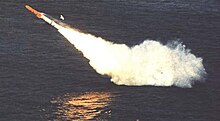UUM-44 SUBROC
| UUM-44 SUBROC | |
|---|---|

A UUM-44 Subroc after leaving the water.
|
|
| Type | Standoff anti-submarine weapon |
| Place of origin | United States |
| Service history | |
| In service | 1964-1989 |
| Used by | United States Navy |
| Production history | |
| Manufacturer | Goodyear Aerospace |
| Specifications | |
| Weight | 4,000 lb (1,800 kg) |
| Length | 22 ft (6.7 m) |
| Diameter | 21 in (53 cm) |
| Warhead | W55 1-5 ktnuclear depth bomb |
|
Detonation
mechanism |
Depth Fuze |
|
|
|
| Engine | Solid rocket booster |
|
Operational
range |
55 km (34 mi) |
| Speed | subsonic |
|
Guidance
system |
Inertial guidance ballistic trajectory |
|
Launch
platform |
Submarine |
The UUM-44 SUBROC (SUBmarine ROCket) was a type of submarine-launched rocket deployed by the United States Navy as an anti-submarine weapon. It carried a 5 kiloton nuclear warhead.
Development began in 1958, with the technical evaluation being completed in 1963. SUBROC reached Initial Operation Capability (IOC) aboard the attack submarine Permit in 1964. When SUBROC reached IOC The US Navy's admiral in charge of weapons procurement stated that SUBROC was " .. a more difficult technical problem than Polaris."
SUBROC could be launched from a 21 inch submarine torpedo tube. After launch, the solid fuel rocket motor fired and SUBROC rose to the surface. The launch angle then changed and SUBROC flew to its destination following a predetermined ballistic trajectory. At a predetermined time in the trajectory, the reentry vehicle (containing the warhead) separated from the solid fuel motor. The 1 to 5 kiloton W55 nuclear depth bomb, dropped into the water and sank rapidly to detonate near its target. A direct hit was not necessary.
The W55 was 35 centimetres (14 in) in diameter, 1 metre (39 in) long, and weighed 213 kilograms (470 lb). Yield was very low for a two-stage thermonuclear device and may only refer to the yield of the primary stage. Some sources suggest the W55 evolved from the experimental bomb tested in the Hardtack I Olive nuclear test on July 22, 1958, which had a full two-stage yield estimated at 202 kilotons. Researcher Chuck Hansen claims based on his US nuclear program research that the W55 and W58 warheads shared a common primary or fission first stage, and that this design was nicknamed the Kinglet primary by Hansen in 2001.
SUBROC's tactical use was as an urgent-attack long-range weapon for time-urgent submarine targets that could not be attacked with any other weapon without betraying the position of the launching submarine by calling for an air-strike, or where the target was too distant to be attacked quickly with a torpedo launched from the submarine. The tactical rationale for SUBROC was similar to that for ASROC or Ikara. An added advantage was that SUBROC's approach to the target was not detectable by the target in time to take evasive action, although the warhead yield would appear to make evasive maneuvers unrealistic. However, SUBROC was less flexible in its use than Ikara or ASROC: since its only payload was a nuclear warhead, it could not be used to provide stand-off fire in a conventional (i.e., non-nuclear) engagement.
...
Wikipedia
